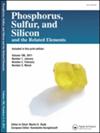基于1,8-萘酰亚胺-三苯胺的荧光开启探针,用于水样和活细胞中噻吩的检测
IF 1.4
4区 化学
Q4 CHEMISTRY, INORGANIC & NUCLEAR
Phosphorus, Sulfur, and Silicon and the Related Elements
Pub Date : 2024-12-03
DOI:10.1080/10426507.2024.2430544
引用次数: 0
摘要
噻吩及其衍生物的毒性对环境和生物系统构成重大威胁。检测它们的迫切需要促使了一种“开启”荧光探针NI-TPA-1的开发,该探针以1,8-萘酰亚胺-三苯胺为发射基团,2,4-二硝基苯为反应位点。引入4-甲氧基噻吩(MTP)后,NI-TPA-1的荧光强度显著提高了18倍,在水溶液中检测限低至20 nM。通过密度泛函理论(DFT)计算阐明了光致电子转移(PET)响应机制,为探针的传感机制提供了有价值的见解。此外,NI-TPA-1在实际水样中对噻吩的成功检测证明了其实用性。探针的多功能性在活细胞成像中得到了进一步的展示,突出了其在体内应用的潜力。这项研究不仅为硫酚的敏感和选择性检测提供了强有力的解决方案,而且强调了NI-TPA-1在环境和生物医学背景下的更广泛意义。本文章由计算机程序翻译,如有差异,请以英文原文为准。
A 1,8-naphthalimide-triphenylamine based fluorescent turn-on probe for thiophenol detection in water samples and living cells
Thiophenol and its derivatives pose a significant threat to the environment and biological systems due to their toxic nature. The imperative need for their detection prompted the development of a "turn-on" fluorescent probe, NI-TPA-1, incorporating 1,8-naphthalimide-triphenylamine as the emission groups and 2,4-dinitrobenzene as the reactive site. Upon introducing 4-methoxythiophenol (MTP), the fluorescence intensity of NI-TPA-1 exhibited a remarkable 18-fold increase, achieving detection limits as low as 20 nM in aqueous solutions. The photo-induced electron transfer (PET) response mechanism was elucidated through density functional theory (DFT) calculations, providing valuable insights into the sensing mechanism of the probe. Furthermore, the practical applicability of NI-TPA-1 was demonstrated through its successful detection of thiophenol in real water samples. The versatility of the probe was further showcased in living cells imaging, highlighting its potential for in vivo applications. This research not only presents a robust solution for the sensitive and selective detection of thiophenol but also underscores the broader significance of NI-TPA-1 in environmental and biomedical contexts.
求助全文
通过发布文献求助,成功后即可免费获取论文全文。
去求助
来源期刊
CiteScore
2.60
自引率
7.70%
发文量
103
审稿时长
2.1 months
期刊介绍:
Phosphorus, Sulfur, and Silicon and the Related Elements is a monthly publication intended to disseminate current trends and novel methods to those working in the broad and interdisciplinary field of heteroatom chemistry.

 求助内容:
求助内容: 应助结果提醒方式:
应助结果提醒方式:


